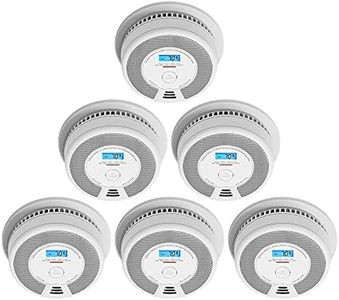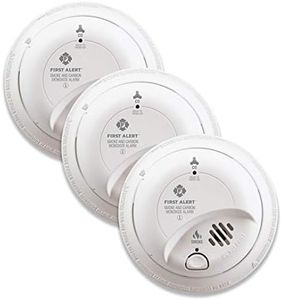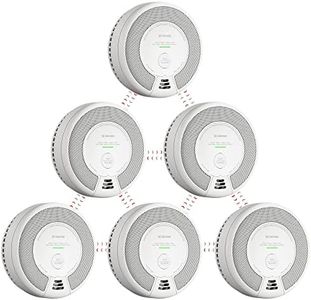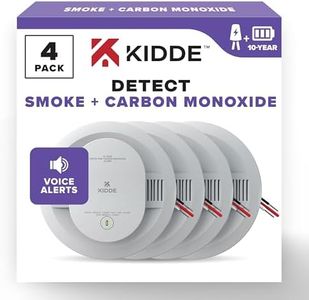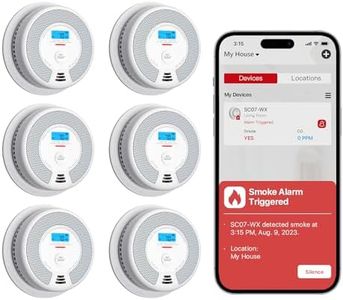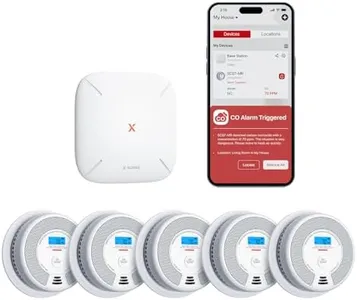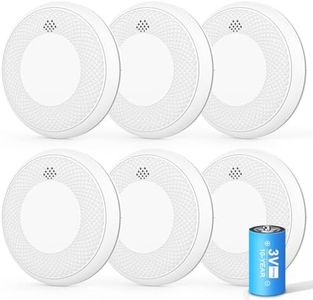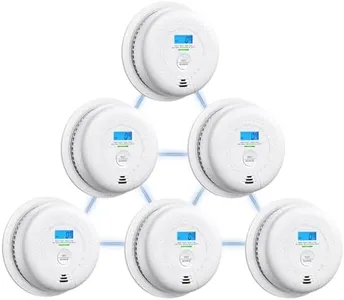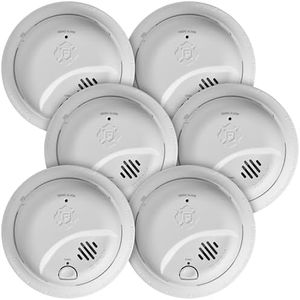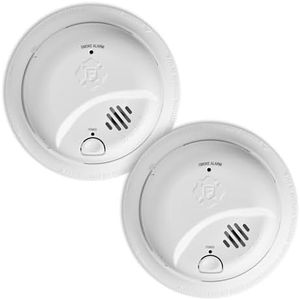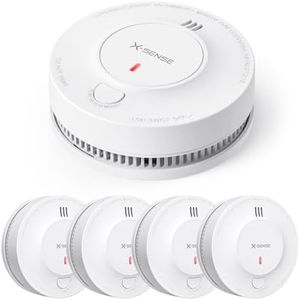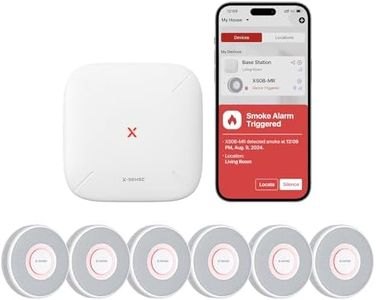10 Best Smoke Detectors 2025 in the United States
Our technology thoroughly searches through the online shopping world, reviewing hundreds of sites. We then process and analyze this information, updating in real-time to bring you the latest top-rated products. This way, you always get the best and most current options available.

Our Top Picks
Winner
X-Sense Wireless Interconnected Combination Smoke and Carbon Monoxide Detector with LCD Display & 10-Year Battery, Over 820 ft Transmission Range, 6-Pack
Most important from
5518 reviews
The X-Sense Wireless Interconnected Combination Smoke and Carbon Monoxide Detector is designed to protect your home with dual sensors: a photoelectric smoke sensor and an electrochemical CO sensor. This 2-in-1 setup means it can detect both smoke and dangerous carbon monoxide levels, giving you comprehensive safety coverage. The detectors work wirelessly and can connect up to 24 units across your home, ensuring that if one alarm sounds, all alarms will alert you simultaneously—helpful for larger homes or multi-room setups.
These detectors run on built-in 10-year lithium batteries, so you won’t need to worry about replacing batteries frequently, which is a great convenience. The included LCD screen shows real-time carbon monoxide levels, battery status, and device health, adding useful information at a glance. Installation requires screwing them into place, and each unit covers about 215 to 430 square feet, so the 6-pack should be sufficient for most medium-sized homes. The detectors connect via RF wireless signals but don’t have Wi-Fi capabilities, so smartphone alerts or remote monitoring are not available with this model.
While the 10-year battery life is excellent, the detectors themselves have a limited warranty period of 5 years, which is important to consider. This product is well suited for homeowners seeking reliable, easy-to-install smoke and CO detection with long-lasting batteries and effective home-wide alerting. However, those wanting smart home integration might need to explore other options.
Most important from
5518 reviews
FIRST ALERT BRK SC9120B-3 Hardwired Smoke and Carbon Monoxide (CO) Detector with Battery Backup, White, Pack of 3
Most important from
27469 reviews
The FIRST ALERT BRK SC9120B-3 is a solid choice for home safety, combining smoke and carbon monoxide detection in one unit. It uses both ionization and electrochemical sensors, which means it can detect fast-burning fires and carbon monoxide effectively. The detectors are hardwired for reliable power but also include battery backup, so they keep working even during power outages. This is important for constant monitoring. One handy feature is that these alarms can interconnect with other compatible First Alert units, so if one goes off, they all do—helping ensure you hear alerts throughout your home.
The alarm sound is loud at 85 decibels, which is typical for smoke detectors and should be enough to wake most people. The unit also has clear indicator lights that show if smoke or carbon monoxide is detected. The single test/silence button is easy to use, and the side-load battery compartment makes battery replacement simple. Tamper-resistant brackets and dust covers help keep the units functioning well over time, reducing false alarms and maintenance hassle.
One consideration is that while the combination sensor is effective, it might not be as specialized as some models that use photoelectric sensors, which can be better at detecting smoldering fires. Installation requires hardwiring, so if you don’t have existing wiring, it may need professional help. Additionally, some users may find the 85-decibel alarm not loud enough in very large or noisy homes. This 3-pack is a practical option for families wanting comprehensive protection with easy maintenance, suitable for most homes seeking a balance between smoke and carbon monoxide detection with dependable power options.
Most important from
27469 reviews
X-Sense Wireless Interconnected Combination Smoke and Carbon Monoxide Detector, 10-Year Battery Powered Fire and CO Alarm, SC06-W, 6-Pack
Most important from
4117 reviews
The X-Sense Wireless Interconnected Combination Smoke and Carbon Monoxide Detector (SC06-W) offers comprehensive protection by detecting both smoke and carbon monoxide. Utilizing photoelectric and electrochemical sensors, it provides reliable detection for different types of hazards. Its standout feature is the wireless interconnection capability, meaning when one alarm triggers, all interconnected alarms will sound, ensuring full home coverage; you can link up to 24 units for large homes or properties.
It’s important to note that it does not have Wi-Fi connectivity, which limits integration with smart home systems but reduces the potential for connectivity issues. The device is powered by a 10-year sealed lithium battery, which reduces the need for frequent battery replacements and maintenance. The built-in test/silence button offers easy control for testing the alarms or silencing them during false alarms. This pack includes six alarms, making it a good choice for comprehensive home safety.
For users prioritizing reliable, interconnected alarms without the need for constant maintenance or battery changes, this product is a strong choice.
